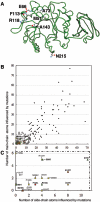High incidence of later-onset fabry disease revealed by newborn screening
- PMID: 16773563
- PMCID: PMC1474133
- DOI: 10.1086/504601
High incidence of later-onset fabry disease revealed by newborn screening
Abstract
The classic phenotype of Fabry disease, X-linked alpha -galactosidase A (alpha -Gal A) deficiency, has an estimated incidence of approximately 1 in 50,000 males. The recent recognition of later-onset variants suggested that this treatable lysosomal disease is more frequent. To determine the disease incidence, we undertook newborn screening by assaying the alpha-Gal A activity in blood spots from 37,104 consecutive Italian male neonates. Enzyme-deficient infants were retested, and "doubly screened-positive" infants and their relatives were diagnostically confirmed by enzyme and mutation analyses. Twelve (0.03%) neonates had deficient alpha-Gal A activities and specific mutations, including four novel missense mutations (M51I, E66G, A73V, and R118C), three missense mutations (F113L, A143T, and N215S) identified previously in later-onset patients, and one splicing defect (IVS5(+1G-->T)) reported in a patient with the classic phenotype. Molecular modeling and in vitro overexpression of the missense mutations demonstrated structures and residual activities, which were rescued/enhanced by an alpha-Gal A-specific pharmacologic chaperone, consistent with mutations that cause the later-onset phenotype. Family studies revealed undiagnosed Fabry disease in affected individuals. In this population, the incidence of alpha-Gal A deficiency was 1 in approximately 3,100, with an 11 : 1 ratio of patients with the later-onset : classic phenotypes. If only known disease-causing mutations were included, the incidence would be 1 in approximately 4,600, with a 7 : 1 ratio of patients with the later-onset : classic phenotypes. These results suggest that the later-onset phenotype of Fabry disease is underdiagnosed among males with cardiac, cerebrovascular, and/or renal disease. Recognition of these patients would permit family screening and earlier therapeutic intervention. However, the higher incidence of the later-onset phenotype in patients raises ethical issues related to when screening should be performed--in the neonatal period or at early maturity, perhaps in conjunction with screening for other treatable adult-onset disorders.
Figures



References
Web Resources
-
- Online Mendelian Inheritance in Man (OMIM), http://www.ncbi.nlm.nih.gov/Omim/ (for Fabry disease)
-
- UCSC Genome Browser, http://genome.ucsc.edu (for markers around the α-Gal A gene)
References
-
- Desnick RJ, Ioannou YA, Eng CM (2001) α-Galactosidase A deficiency: Fabry disease. In: Scriver CR, Beaudet AL, Sly WS, Valle D, Kinzler KE, Vogelstein B (eds) The metabolic and molecular bases of inherited disease. McGraw-Hill, New York, pp 3733–3774
-
- Elleder M, Bradova V, Smid F, Budesinsky M, Harzer K, Kustermann-Kuhn B, Ledvinova J, Belohlavek, Kral V, Dorazilova V (1990) Cardiocyte storage and hypertrophy as a sole manifestation of Fabry’s disease: report on a case simulating hypertrophic non-obstructive cardiomyopathy. Virchows Arch A Pathol Anat Histopathol 417:449–45510.1007/BF01606034 - DOI - PubMed
-
- von Scheidt W, Eng CM, Fitzmaurice TF, Erdmann E, Hubner G, Olsen EG, Christomanou H, Kandolf R, Bishop DF, Desnick RJ (1991) An atypical variant of Fabry’s disease with manifestations confined to the myocardium. N Engl J Med 324:395–399 - PubMed
-
- Nakao S, Kodama C, Takenaka T, Tanaka A, Yasumoto Y, Yoshida A, Kanzaki T, Enriquez ALD, Eng CE, Tanaka H, Tei C, Desnick RJ (2003) Fabry disease: detection of undiagnosed hemodialysis patients and identification of a “renal variant” phenotype. Kidney Int 64:801–80710.1046/j.1523-1755.2003.00160.x - DOI - PubMed
Publication types
MeSH terms
Grants and funding
LinkOut - more resources
Full Text Sources
Other Literature Sources
Medical

